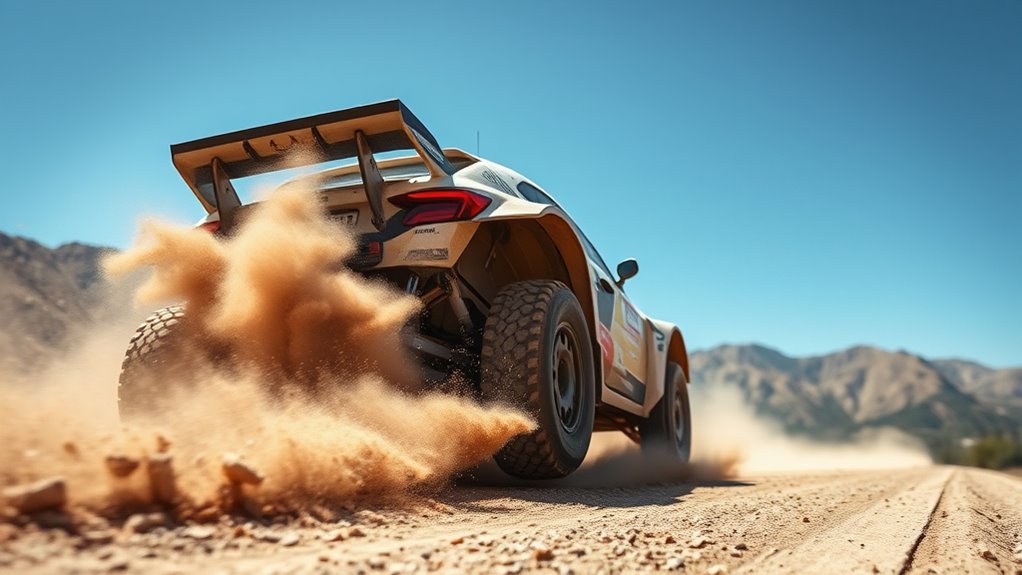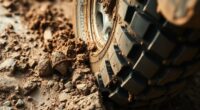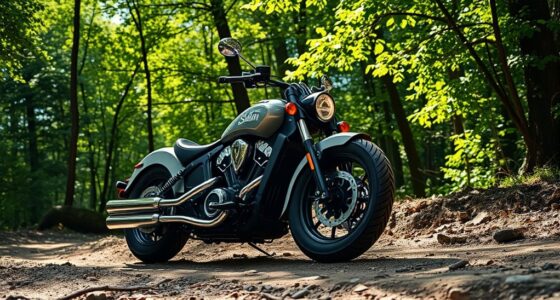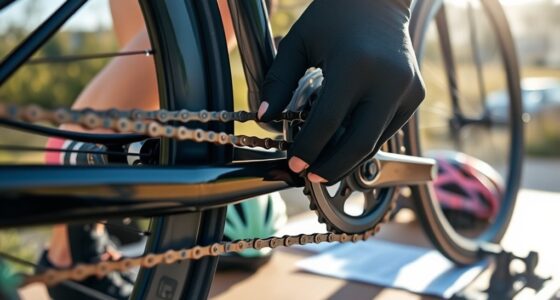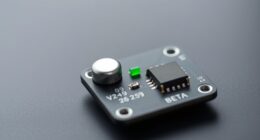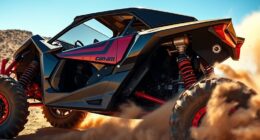Wheelspin on loose terrain occurs when your tires can’t generate enough grip due to reduced friction, often caused by applying too much torque or power too quickly. Surface conditions like mud or gravel make it harder for tires to bite, and design features like deep treads can help. Managing your throttle carefully, optimizing tire pressure, and using technology like traction control can improve grip. Keep exploring to uncover how these factors work together to affect traction physics.
Key Takeaways
- Wheelspin occurs when torque exceeds the traction limit between tire and loose terrain, causing wheels to slip.
- Reduced surface friction on loose terrain decreases the maximum grip, increasing wheelspin risk.
- Excessive torque application overcomes frictional forces, leading to tires spinning faster than the ground can resist.
- Proper tire design and pressure improve contact and grip, reducing wheelspin on loose surfaces.
- Traction control systems detect wheel slip and adjust power to prevent or minimize wheelspin.
The Basics of Friction and Traction
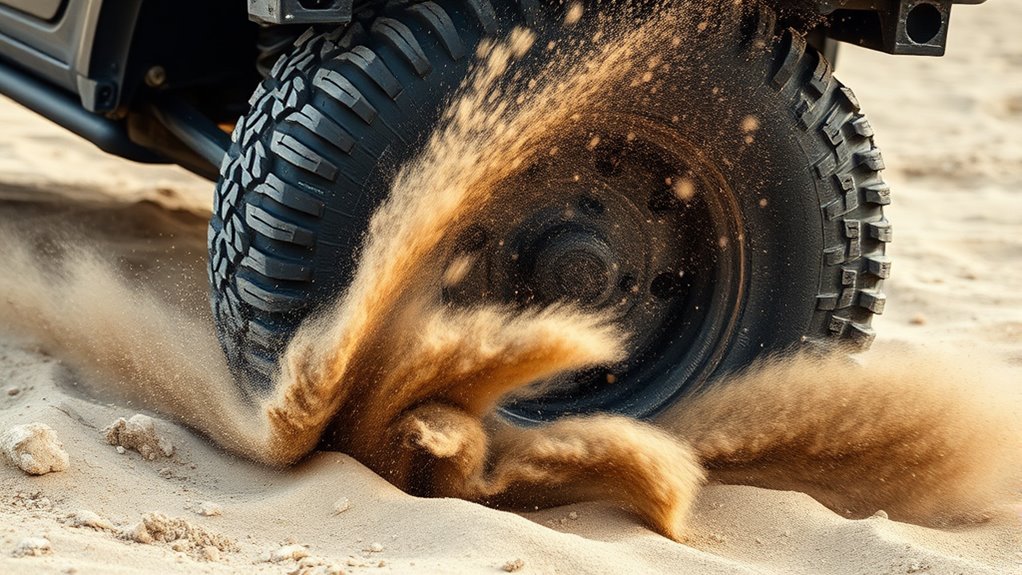
Friction is the force that opposes the motion between two surfaces in contact, and it plays a crucial role in providing traction for vehicles. When your tires contact the ground, friction allows your wheels to grip the surface and transfer power into movement. The level of traction depends on the type of terrain and the condition of your tires. On loose terrain, like dirt or gravel, friction is often reduced because the surface doesn’t provide as much grip. This makes it easier for wheels to spin, especially when you accelerate quickly. Understanding the basics of friction helps you grasp why wheelspin occurs and how different surfaces affect your vehicle’s ability to maintain traction, especially on challenging terrains.
How Torque Affects Wheel Behavior
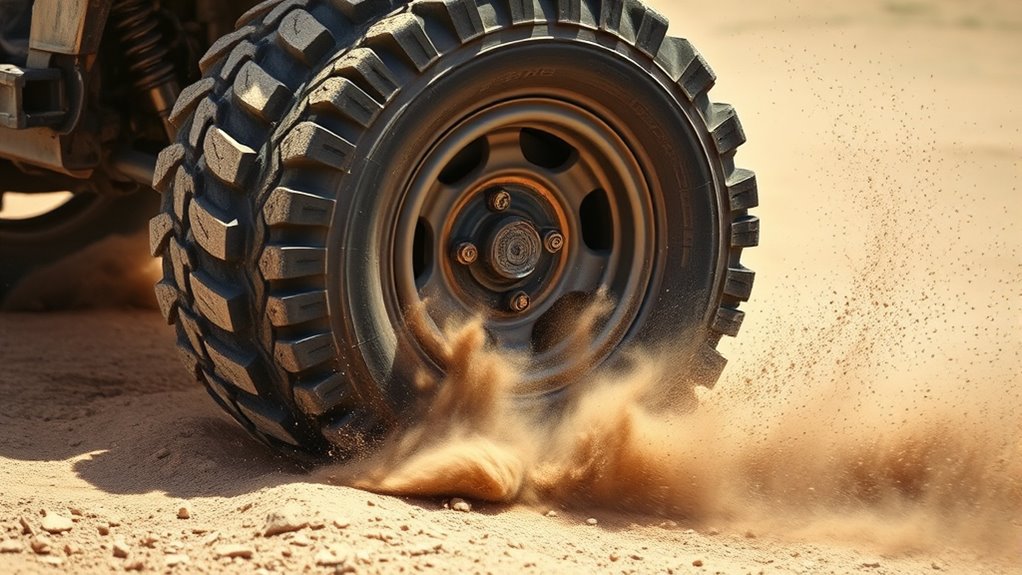
When you apply torque to your wheels, it directly influences how much grip you get. Too much torque, and your wheels can spin freely, causing slip instead of traction. Understanding how torque distributes and affects grip helps you control wheel behavior on loose terrain. Upgrading your suspension can also improve how your vehicle responds to torque and maintains traction under challenging conditions.
Torque’s Role in Grip
Torque directly influences how a wheel interacts with loose terrain by determining the amount of rotational force applied to it. When you apply more torque, the wheel is pushed harder against the ground, increasing your grip if the terrain can handle it. However, if torque exceeds what the terrain’s friction can support, the wheel will start to slip, losing traction. Conversely, too little torque may prevent the wheel from turning effectively, reducing grip altogether. The key is balancing torque to maximize grip without exceeding the terrain’s friction limits. By understanding this relationship, you can optimize your driving technique—applying enough torque to maintain traction without causing wheel spin. This balance is essential for maintaining control and avoiding unnecessary wheel slip on loose surfaces. Additionally, traction control systems can assist in managing torque application for optimal grip.
Excess Torque Causes Slip
Applying too much torque pushes the wheel beyond the terrain’s grip limit, causing it to slip. When you deliver excessive torque, the wheel’s traction can’t hold, and it starts spinning faster than the terrain can resist. This slip reduces your vehicle’s ability to accelerate efficiently and can lead to loss of control. To visualize this, consider the following:
| Torque Level | Wheel Behavior |
|---|---|
| Low | Good grip, no slip |
| Moderate | Grip begins to fade |
| Excessive | Wheel slips, loss of traction |
| Very High | Wheel spins freely, no forward progress |
| Ideal | Balanced torque for grip |
Understanding the role of traction is essential for maintaining control on loose terrain.
Torque Distribution Dynamics
How torque is allocated across your vehicle’s wheels considerably influences their behavior on loose terrain. When more torque goes to one wheel, that wheel is more likely to slip or spin, especially if it loses traction. Modern vehicles use different systems—like limited-slip differentials and torque vectoring—to manage this distribution. These systems transfer torque to the wheel with better grip, helping maintain stability and traction. If torque is unevenly split, the slipping wheel loses power quickly, while the other gains more, which can cause imbalance. Proper torque distribution ensures that power is delivered efficiently, reducing wheelspin and increasing control. Understanding how torque flows helps you optimize your vehicle’s performance and avoid getting stuck or losing control on loose surfaces. Effective torque management is essential for maintaining traction and vehicle stability in challenging conditions.
The Role of Tire Design and Material
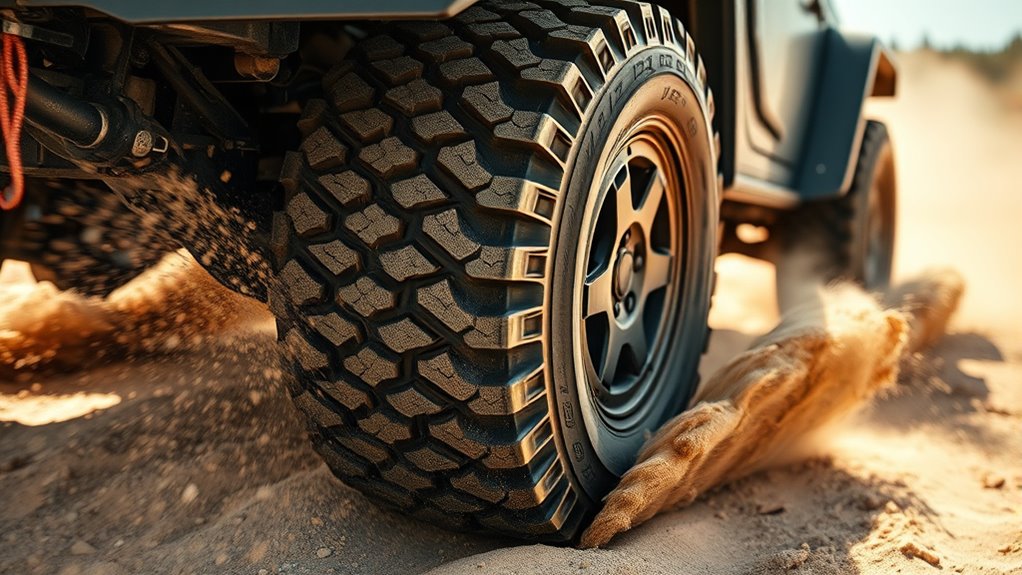
Your tire design is crucially important to wheelspin, especially through tread patterns that grip loose terrain effectively. The rubber compound‘s composition also plays a significantly important role in providing the right balance of flexibility and traction. Understanding these factors helps optimize your tires for better performance on challenging surfaces. Additionally, selecting quality ingredients and formulations can enhance the durability and grip of the tires under various conditions.
Tread Pattern Effectiveness
The effectiveness of a tire’s tread pattern plays a crucial role in managing wheelspin on loose terrain, as it directly influences traction and grip. Tread patterns work by channeling away loose dirt, mud, or sand, preventing buildup that reduces contact with the ground. Aggressive, deep lugs increase biting edges, enhancing grip during acceleration. Conversely, more open patterns prevent clogging and maintain traction in softer surfaces. The arrangement and shape of these patterns affect how well the tire digs into loose material, providing stability and reducing wheelspin. You’ll find that different terrains require specific tread designs; for example, mud-terrain tires have larger, spaced lugs, while all-terrain tires balance open patterns with smaller features for versatility. Proper tread pattern selection optimizes traction, minimizes wheelspin, and improves overall vehicle control.
Rubber Compound Composition
What role does rubber compound composition play in controlling wheelspin on loose terrain? It directly affects how your tires grip the surface. Softer compounds provide better traction because they conform more easily to uneven surfaces, increasing grip and reducing wheelspin. However, they wear out faster, especially on rough terrain. Harder compounds are more durable but offer less initial grip, making wheelspin more likely. The balance of flexibility and durability in the rubber mix influences how effectively your tires can transfer power without losing traction. Additionally, additives like silica can improve grip on loose surfaces by enhancing the tire’s ability to deform and grip irregularities. Choosing the right rubber composition involves considering the specific terrain and driving conditions, and proper selection can significantly improve traction and control in challenging environments.
Surface Conditions and Their Impact on Grip
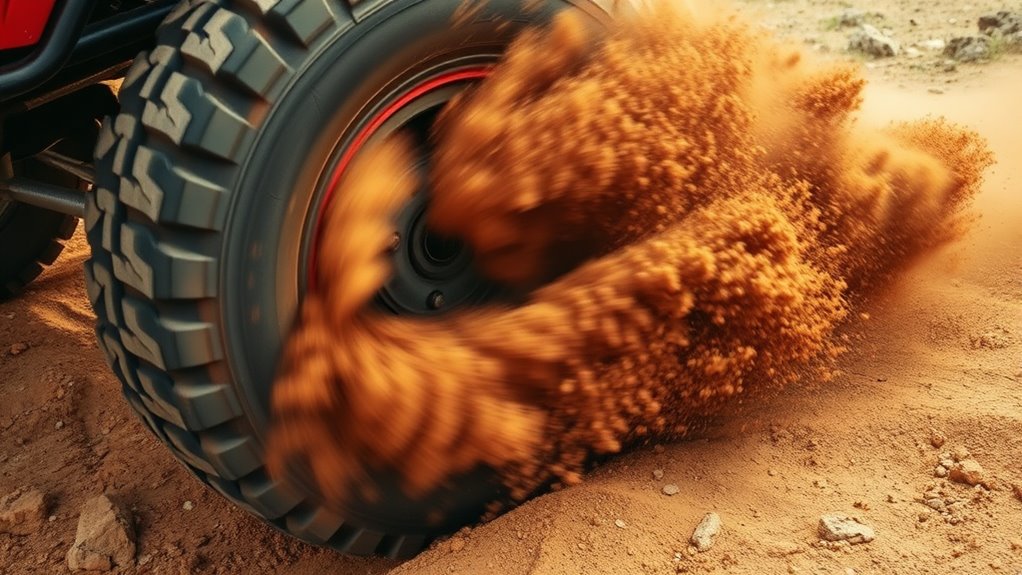
Surface conditions play a crucial role in determining grip and the likelihood of wheelspin on loose terrain. When the ground is dry and firm, your tires can bite into it better, providing more traction. Conversely, wet or muddy surfaces reduce friction, making wheelspin more likely. Loose gravel or sand can shift under your tires, decreasing grip and causing instability. The particle size and moisture content influence how much grip you gain or lose; fine, dry surfaces offer more grip than loose or wet ones. Additionally, surface texture affects traction—rougher textures increase grip, while smoother surfaces lead to slipping. Recognizing these factors helps you anticipate how your vehicle will respond, enabling better control and adjustments to prevent wheelspin on varying terrains. Understanding surface mechanics can further enhance your ability to adapt to different conditions and maintain optimal traction.
The Balance Between Driving Force and Resistance
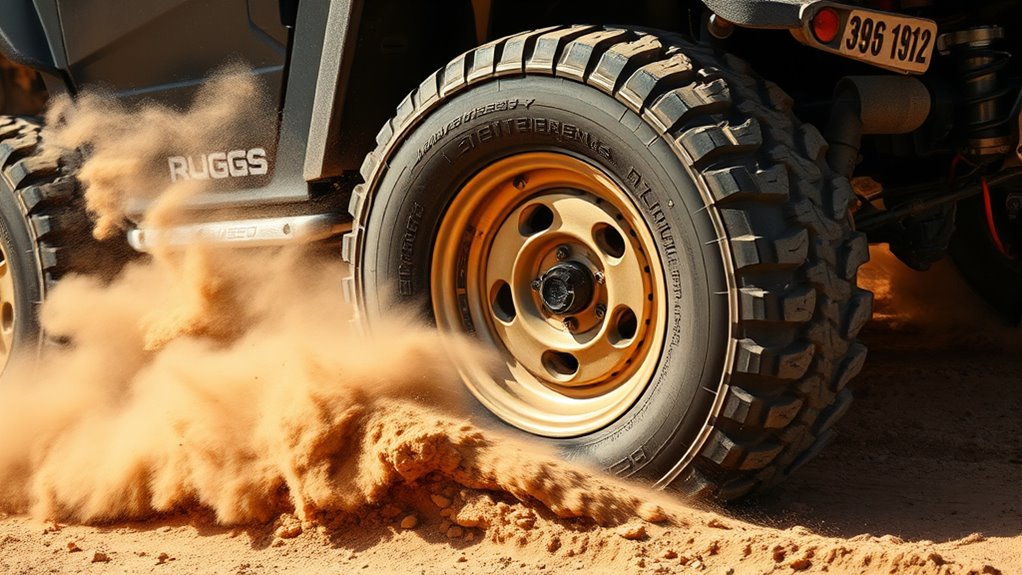
Understanding the balance between driving force and resistance is essential for preventing wheelspin on loose terrain. When you accelerate, your vehicle applies a driving force to the wheels. If this force exceeds the grip available from the terrain, the wheels start to slip. Resistance, including friction and the terrain’s grip, opposes this force. On loose surfaces, resistance is low, so even a small increase in driving force can cause wheelspin. To maintain control, you need to keep the driving force within the limits of the terrain’s resistance. This balance depends on factors like tire traction, weight distribution, and acceleration rate. Additionally, tuning modifications such as suspension upgrades and tire enhancements can influence how well your vehicle maintains traction under these conditions. By understanding this relationship, you can better modulate your throttle and prevent the wheels from spinning excessively.
Techniques to Minimize Wheelspin
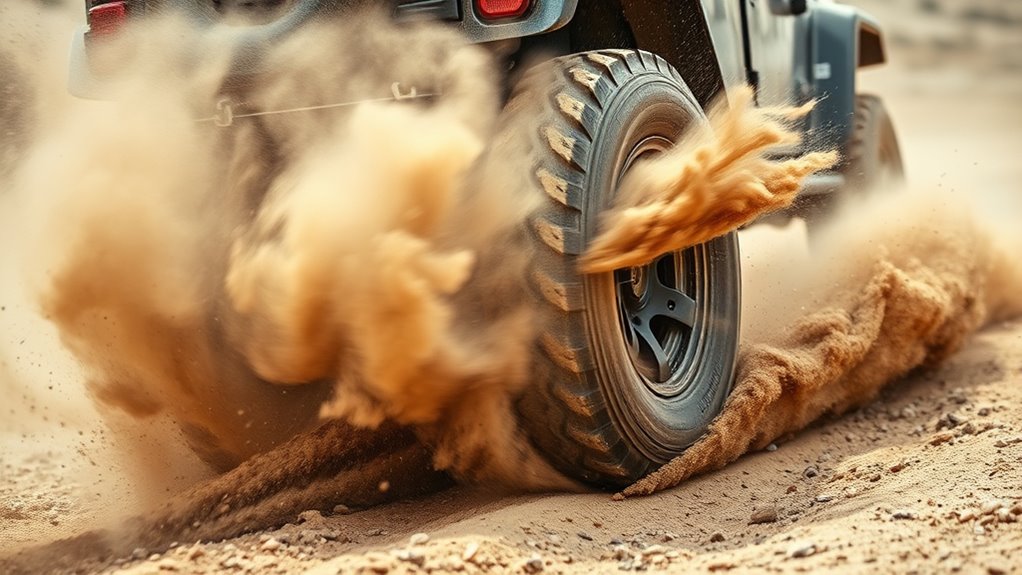
To minimize wheelspin on loose terrain, you should start by applying gentle, controlled throttle increases rather than full acceleration. This helps prevent sudden torque surges that can break traction. Maintain steady throttle input, focusing on smooth, incremental increases as the wheels begin to grip the surface. Using a low gear can also help by providing better control over power delivery and reducing wheel slip. If you feel wheelspin starting, ease off the throttle slightly to regain traction. Additionally, avoiding abrupt steering inputs prevents unnecessary load on the tires, which can cause slipping. Proper tire pressure is pivotal; slightly deflating tires increases their contact patch and grip. Choosing the right tires can make a significant difference in traction on loose terrain. By adopting these techniques, you improve traction, reduce wheelspin, and maintain better control on loose terrain.
Advances in Technology to Improve Traction
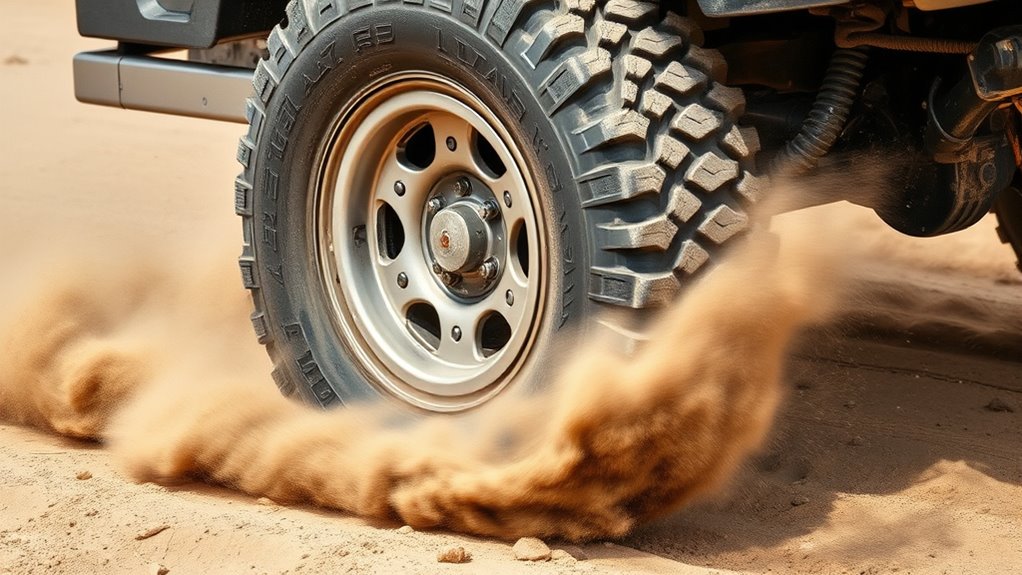
Recent technological advancements have markedly enhanced traction control on loose terrains. These innovations help you maintain grip and prevent wheelspin more effectively. A variety of innovative plant containers now incorporate features that further improve traction for gardening tools and accessories used in outdoor settings. 1. Electronic Stability Control (ESC) systems now automatically adjust brake force and engine power, keeping your vehicle on course. 2. Tire pressure monitoring systems (TPMS) enable you to optimize tire pressure for better traction on loose surfaces. 3. Advanced traction control systems (TCS) use sensors to detect wheel slip and adjust power delivery instantly, minimizing spin and maximizing grip.
These tech improvements empower you to navigate challenging terrains with greater confidence. By integrating these systems into your vehicle, you can achieve better stability, reduce wheelspin, and unlock (or gain access to) more traction, even on the most unpredictable surfaces.
Frequently Asked Questions
How Does Wheelspin Affect Vehicle Control and Safety?
Wheelspin can greatly impact your vehicle control and safety. When your wheels spin, you lose traction, making it harder to steer and stop effectively. This can lead to skidding or sliding, especially on loose or slippery surfaces. You might feel a loss of stability, increasing the risk of accidents. To stay safe, you should adjust your driving, avoid rapid acceleration, and guarantee your tires have good tread and proper inflation.
What Role Does Weight Distribution Play in Wheelspin?
Think of weight distribution as the foundation of a house; if it’s off balance, everything else suffers. When you have proper weight over your drive wheels, it increases traction, reducing wheelspin. Conversely, if weight shifts away, wheelspin becomes more likely, causing loss of control. So, keeping your vehicle’s weight balanced helps you grip the terrain better, giving you more control and safety on loose or uneven surfaces.
Can Different Driving Styles Influence Wheelspin Frequency?
Your driving style definitely impacts how often you experience wheelspin. Aggressive acceleration, quick throttle inputs, and sharp turns put more stress on your tires, increasing the chance of spinning. Smooth, controlled driving reduces wheelspin by maintaining consistent power delivery. By modulating your throttle and steering with finesse, you help keep your tires gripping the surface better, especially on loose terrain where traction is more easily broken.
How Does Temperature Impact Tire Grip on Loose Terrain?
You might think higher temperatures always improve tire grip, but that’s not true on loose terrain. Warmer tires can soften rubber, increasing contact and grip initially, yet excessive heat causes tire degradation and loss of traction. Cooler temperatures make rubber harder, reducing grip. So, maintaining ideal tire temperature is essential—too hot or cold can cause slipping. Your driving style and terrain conditions also interplay with temperature to influence wheelspin.
Are There Environmental Factors That Worsen Wheelspin Conditions?
Environmental factors like wet, icy, or muddy conditions can worsen wheelspin because they reduce tire grip and increase slip. Wind can also affect vehicle stability, making it harder to control traction. Dust and loose debris clog tire treads, decreasing friction. Additionally, low visibility from fog or heavy rain can cause you to misjudge terrain, increasing the chances of wheelspin. Always adjust your driving to these conditions for better control.
Conclusion
So, next time you’re stuck spinning your wheels on loose terrain, remember it’s all physics—blame the friction, tire design, and surface chaos. Instead of blaming your skills, maybe thank the universe for making traction a stubborn enemy. With all these tech advances, you’d think getting grip would be effortless, but nope—nature’s still playing hard to get. Keep dreaming of perfect traction; reality’s just waiting to spin you right round.
